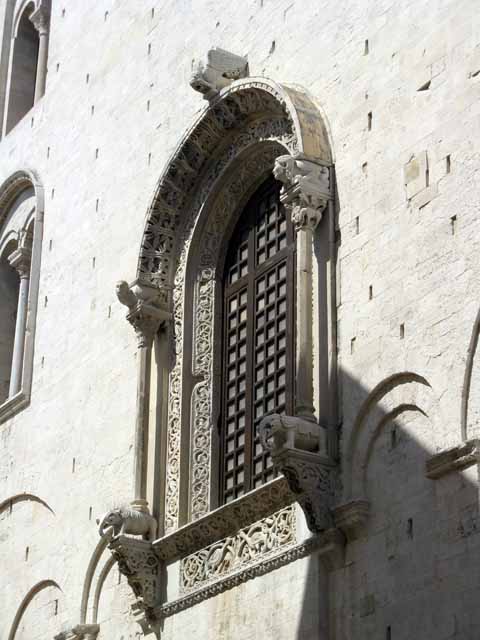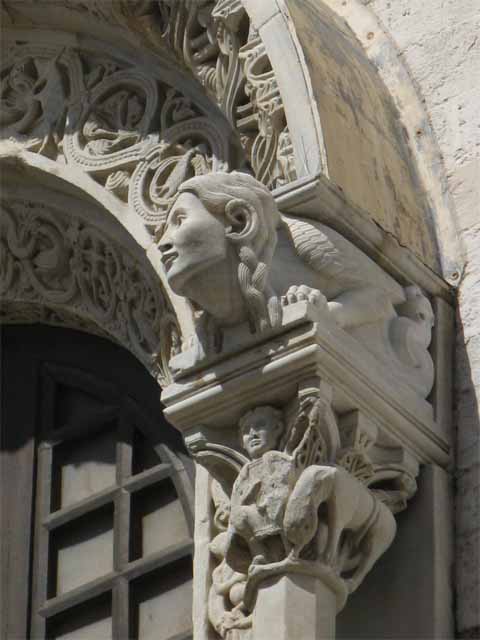
THE CATHEDRAL OF BARI

Bari, Cathedral of San Sabino
(Berthold Werner, CC BY-SA 3.0, https://commons.wikimedia.org/w/index.php?curid=61448663)
The Cathedral of Bari, dedicated to Saint Sabinus and the Virgin Hodegetria, that is “she who points the way”, seems to hardly emerge from the noisy alleys of the old town, almost hidden in its heart and by the more famous and venerated Basilica di San Nicola. It is the bell tower – the only one that stands out among the low roofs of the village and has remained a distinctive point of reference in the urban skyline for centuries – that makes the church imposing.
Internally and on the tripartite white façade it is possible to read its history, which began in ancient times in the succorpo[1], adorned with beautiful Early Christian mosaics, and unfolds over the centuries until the Baroque additions, visible in the crypt and the statues, with their emphasized theatricality, that enrich the main portal.
The building took on its current appearance between 1170 and 1178, when it was completely rebuilt, after having been razed to the ground by William I, called the Wicked, following the uprising of Bari people against the new Norman lords.
The façade is divided into three sections by pilaster strips, thus externally reflecting the inner division of the naves. The tops of the slopes have hanging arches that lie on shelves carved with snakes and animals, directly taken from the rich and creative Medieval bestiary.
A large rose window, decorated with statues of monsters, dragons, snakes and grotesque figures, dominates the upper register in line with the main portal. The apse area is not externally visible thanks to a rear façade that has a wonderful large window, considered as one the masterpieces of 12th-century Romanesque sculpture. This wide scalloped opening, framed by a baldachin supported by hanging columns, is abundantly carved with eastern plant and animal motifs, including in particular a mysterious harpy.

Bari, Cathedral, rear façade, apse window.

Bari, Cathedral, rear façade, a detail of the apse window
The creative sculptural external Romanesque decoration is in contrast with the austere and mystical inner atmosphere, where the silence of the deep naves is enlivened only by the imposing effect created by the arcades, in counterpoint to the elegant three-lancet windows of the upper matronea.

Bari, Cathedral of San Sabino, interior.
(Porcullus Marek Postawka – Opera propria, CC BY 3.0, https://commons.wikimedia.org/w/index.php?curid=3526917)
The oldest core of the church is located five meters below the Cathedral level and dates back to the 6th century. It is an Early Christian basilica that has maintained its ancient charm nearly intact. The area, formerly divided into three naves, now keeps the foundations of the original columns and a mosaic pavement ornate with geometric motifs and plant and animal elements. It is still possible to read an inscription that mentions a man named Timothy who paid for the floor mosaic decoration to honor a vow.
The crypt hosts the icon of the Virgin Hodegetria, known also as Madonna of Constantinople, an object of deep devotion. Tradition has it that the board came to Bari from Constantinople in the 8th century, when during iconoclasm the Eastern Roman Emperor had ordered to destroy all the icons. Actually, it is a 16th-century board that reproduces the Byzantine iconographic type of the Virgin enthroned who points to the Child thus showing the way to heaven, that is Christ.
Over the 18th century, the board was changed, and according to the style and aesthetics of that period, it was protected and covered with a sumptuous silver riza.

Icon of the Virgin Hodegetria
(Sailko – Opera propria, CC BY 3.0, https://commons.wikimedia.org/w/index.php?curid=58901057)
- T. N.: The vast hypogeum church underneath the Cathedral. ↑